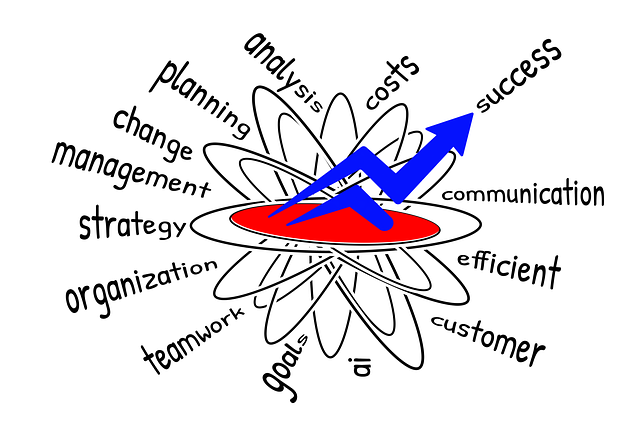Understanding ROI in SEO is crucial for businesses aiming to grow online. By attributing revenue from organic search results to marketing strategies, companies can measure the effectiveness of their SEO efforts. This involves tracking key metrics like CTRs, conversion rates, and cost per acquisition. SEO growth strategies should be data-driven, focusing on high-yielding areas for short-term gains and long-term rankings. Aligning SEO goals with business objectives maximizes online presence potential, driving tangible results and boosting profitability. Keyword research using tools like Google Keyword Planner helps attract targeted audiences. On-page optimization improves visibility and user experience. Building authority through high-quality content and link building enhances trust and search engine rankings. Data-driven content creation, based on analytics, targets appealing topics to rank higher and drive interactions. Competitive analysis uncovers market gaps and opportunities. Continuous optimization adapts to changing trends, algorithms, and user preferences for sustained SEO growth.
In today’s digital landscape, ROI-driven SEO tactics are essential for businesses aiming to thrive online. This article delves into a comprehensive guide on unlocking sustainable SEO growth strategies. From understanding the financial perspective of return on investment (ROI) in SEO to aligning search engine optimization (SEO) goals with business objectives, we explore key metrics for measuring success. We discuss strategic keyword research, powerful on-page optimization techniques, and effective off-page tactics. Additionally, data-driven content creation strategies, competitor analysis, and continuous optimization are highlighted for long-term growth in a dynamic market.
Understanding ROI in SEO: The Financial Perspective

Understanding ROI (Return on Investment) in SEO is crucial for any business looking to optimize its online presence and drive sustainable growth. From a financial perspective, ROI is a measure of how effective your SEO efforts are in generating value. It’s about attributing revenue generated from organic search results directly to the marketing strategies that contributed to those results. By evaluating key metrics like click-through rates, conversion rates, and cost per acquisition, businesses can assess the financial impact of their SEO investments.
This data-driven approach allows for the prioritization of SEO growth strategies. Businesses can identify which keywords, content types, and link-building tactics deliver the best return on their time and resources. With this understanding, they can allocate budgets more efficiently, focusing on high-yielding areas that bring in substantial revenue while optimizing for long-term search engine rankings.
Aligning SEO Goals with Business Objectives

In aligning SEO goals with business objectives, organizations can harness the full potential of their online presence to drive tangible results and boost ROI. This involves a strategic approach where SEO growth strategies are tailored to support overarching business targets, whether it’s increasing brand awareness, generating leads, or expanding market reach. By integrating SEO into the fabric of the company’s digital strategy, businesses ensure that their online efforts are aligned with their overall vision and mission.
This alignment goes beyond just keyword optimization and content creation; it involves a deep understanding of the target audience, competitor analysis, and the continuous refinement of SEO tactics to stay ahead in a dynamic digital landscape. When SEO is treated as an integral part of business strategy, it becomes a powerful tool for achieving measurable outcomes that translate directly into increased profitability and sustainable growth.
Key Metrics for Measuring SEO Success

When evaluating the success of your SEO efforts, tracking the right metrics is crucial for any ROI-driven SEO tactic. Key performance indicators (KPIs) such as organic traffic, click-through rates (CTRs), and conversion rates offer valuable insights into how effectively your search engine optimization strategies are performing. Organic traffic measures the number of visitors coming from search engines, indicating the visibility and reach of your website.
CTRs, on the other hand, represent the percentage of users who click on a result after seeing it in the search results. Higher CTRs suggest that your SEO efforts are making content more appealing to potential customers. Conversion rates track how many visitors take desired actions, like making purchases or signing up for newsletters, which directly links to business goals and ROI calculations. Regularly analyzing these metrics helps identify areas of success and opportunities for improvement in your SEO growth strategies.
Keyword Research: Finding High-Value Keywords

Keyword research is a fundamental step in any successful SEO growth strategy. It involves identifying and understanding the terms and phrases that potential customers use when searching for products or services related to your business. By focusing on high-value keywords, you can attract a more targeted audience and improve the overall quality of traffic to your website.
Tools like Google Keyword Planner, SEMrush, and Ahrefs can provide valuable insights into search volume, competition, and user intent. Using these tools, businesses can uncover long-tail keywords that offer better ROI because they have lower competition but still receive a decent amount of searches. This strategic approach ensures that marketing efforts are allocated efficiently, maximizing the impact on business growth and profitability.
On-Page Optimization for Maximum Impact

Maximizing on-page optimization is a cornerstone of any successful ROI-driven SEO strategy. It involves refining your website’s content and structure to not only appeal to search engines but also enhance user experience, ultimately driving conversions. By focusing on relevant keyword integration, high-quality, unique content creation, and meta tag optimization, you can significantly boost your site’s visibility and attract the right audience. These strategies form the backbone of effective SEO growth tactics, ensuring that each page contributes optimally to overall search engine rankings.
When implementing on-page optimizations, it’s crucial to strike a balance between keyword density and natural language usage. Overstuffing keywords can raise red flags with search engines, while neglecting them altogether may hinder your content’s ability to rank for relevant searches. Regularly updating content, optimizing images with alt tags, and ensuring mobile responsiveness are also vital components that contribute to a robust on-page SEO strategy, ultimately driving measurable ROI through improved website traffic and increased engagement.
Off-Page Tactics to Boost Authority and Trust

Building authority and trust is paramount for any successful SEO growth strategies. Off-page tactics, beyond optimizing your website, play a pivotal role in establishing your brand’s credibility with search engines and potential customers. One such powerful method is engaging in high-quality content creation across various platforms. This involves sharing informative blog posts, infographics, or videos that address your target audience’s pain points and interests. By consistently providing value, you position your business as an authority in its niche, attracting organic traffic and fostering trust with your audience.
Additionally, link building remains a cornerstone of effective off-page SEO. Acquiring backlinks from reputable, relevant websites signals to search engines that your content is valuable and trustworthy. This can be achieved through guest blogging on influential sites, securing media mentions, or collaborating with industry partners. Each successful link-building effort contributes to raising your domain authority, making your website more visible and credible in search results.
Data-Driven Content Creation Strategies

In today’s digital era, data-driven content creation strategies have become indispensable for effective SEO growth tactics. By leveraging analytics tools and understanding audience behavior, businesses can identify high-value keywords and topics that resonate with their target market. This involves analyzing search trends, user demographics, and engagement metrics to create relevant, valuable content that not only ranks higher in search engine results but also drives meaningful interactions.
Content creators should focus on producing pieces that address specific pain points and provide actionable solutions. Optimizing existing content based on data insights can enhance its reach and authority, while consistently creating new material keeps the audience engaged and signals to search engines that the site is active and valuable. This holistic approach ensures that SEO efforts are not just tactical but strategic, leading to sustained growth and improved online visibility.
Analyzing Competitors for Informed Decisions

In today’s digital landscape, understanding your competitors’ strategies is a vital part of crafting effective SEO growth strategies. By analyzing their online presence and performance, businesses can gain valuable insights into what works in a crowded market. This competitive analysis involves scrutinizing their website structure, content strategy, keyword usage, and backlink profiles to identify gaps and opportunities that can set your brand apart.
Knowing your competitors’ strengths and weaknesses allows for more informed decisions regarding target keywords, content creation, and link-building campaigns. It enables businesses to focus on areas where they can outperform, ensuring their SEO efforts are ROI-driven and aligned with market demands. This strategic approach not only helps in gaining a competitive edge but also contributes to long-term success in the online arena.
Continuous Optimization and Iteration for Long-Term Growth

In the dynamic landscape of digital marketing, continuous optimization and iteration are not just desirable but essential for long-term success with SEO growth strategies. It’s a process that involves regularly reviewing, testing, and refining your search engine optimization efforts to adapt to the ever-changing algorithms and user preferences. By staying agile, you can identify which tactics drive the most valuable ROI, making data-driven decisions to enhance your online visibility and attract your target audience.
Regular updates to content, meta tags, and site structure are crucial components of this cycle. It ensures that your website remains relevant and engaging while aligning perfectly with user search queries. Through iterative testing, you can uncover new keywords, optimize for mobile usability, and improve page load speeds, all of which contribute to a better user experience and ultimately drive sustained SEO growth.
